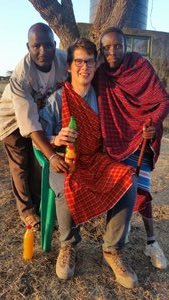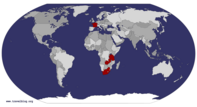Advertisement
Published: July 11th 2016

 Drinking the 'Local Brew'
Drinking the 'Local Brew'
The drink was a mixture of aloe vera and honey.Hello again,
As promised, I am giving you a 2nd post about my Maasai adventure. Apologies that it's later than expected, after leaving the relative reliability of solar power in Ngorongoro, I am now trying to get used to the unpredictability of the generator power in Zanzibar. Power cuts are daily which means I have often had WiFi failure whilst writing this, causing myself to regularly re-write.
I have never experienced a group of people that are so welcoming to strangers. From day one, nearly every Maasai man I came across wanted to know something about me, whether it was where I came from or why I was there (unfortunately, the women were always more subdued and shy, mainly due to the patriarchal society they had been raised in). Often I was also asked about my thoughts on the Maasai; they seemed to enjoy having a Westerner analyse their culture. During my initiation tour, I was introduced to the Chairman of the village, Sabore. He was a fascinating person to talk to and told me that he loved having westerners in his village because they are "intelligent" and know how to improve their society, and quality of life. I
instantly got a strong understanding of the mentality of this tribe. They want to modernise and integrate themselves into our increasingly globalised world, but still ensure that they are able to keep their culture and traditions; and their identity.
Let me just take a moment to give you the basics of Maasai life. Everything begins and ends with their livestock, particularly cows. Whilst they still trade with money, the true measurement of wealth is how many cows you have. This is also where the necessity of having more than one wife comes from. I was told by Mepu, my Maasai coordinator who works for Projects Abroad, that if a man has 300 cows, he cannot possibly expect one wife to be able to milk and care for all of them. He needs another wife, or two or three, to help her out. You see to us, marriage represents the legal and spiritual binding of two people, promised to each other and only each other for the rest of time; to the Maasai, marriage is a recruitment drive. Gender discrimination and inequality aside, it was a logically efficient system. More wives also meant more children! Their role at home is
to help herd the cows and look after them whilst they are feeding, keeping an eye out for predators. I tried to explain that actually, the more wives and children a man had, then the more money he would have to spend and the more cows he would have to sell or kill to provide for them. However, this logic seemed to fall on deaf ears; perhaps the language barrier suddenly became a problem.
Ownership of cows and goats also comes with other challenges. It is very difficult to find them all enough grass to eat and water to drink, especially during the dry season. Therefore, the Maasai must take their herd many miles away in order to find sustenance, and could often be away from home for months at a time. I couldn't help but notice that the problem of saving themselves from starvation had been replaced with saving their food from starvation. Some of the wives and children would come with them in order to help herd the cattle (and cook food for the husband obviously!), but some would also be expected to stay to look after the house, keep the children going to school, and looking
after any businesses that they had at home, such as a shop. However, education is only compulsory up to the end of primary school, and secondary schools have fees to be paid for by the parents, so it is common that most Maasai children will drop out after their primary education and remain at home to help their parents.
The Maasai men go through very distinct stages in their lives, and each transition comes with its own ceremony and custom. They remain children up until they reach their teens and are ready for circumcision, after which they are warriors. There is no set age for circumcision as the parents let the child decide when they are ready, but they usually are done between the ages of 13 and 18. The reason the decision is left to the boy is because they must not cry or convey any sign of pain whilst they are being circumcised without anaesthetic, otherwise they will not be considered men and will bring great shame on the family; hence it's best for the boy to say when he is capable of going through such an ordeal. As well as this, in order to give the
boy as much chance as possible to not cry, they also put them through months of preparation - toughening them up through either small beatings, and verbal abuse. They keep them awake during the night before, and perform the procedure during the colder hours of 5am, although I doubt there is ever a nice time to get your John Thomas cut. This is then followed in the afternoon by a mass celebration with hundreds of guests feasting on traditional food and drink. The men and women also each perform their respective jumping dances whilst chanting and throat singing. I was stunned by how it's such a part of life - a rite of passage - that the boys are so willing to do it, even look forward to it. I even attended one ceremony of a boy who had an American mother and a Maasai father (they met when the women came to Tanzania on safari, and the man was her guide), and he was more than willing to go through with it despite his American education.
Once they are warriors, they are now responsible for the protection of the village and tribe from any attackers. As the Maasai
are a peaceful people, and have not been at war since the early 90s this position is mostly ceremonial. After a period of roughly 15 years, warriors of the same generation will then all be moved up into junior eldership. Once their own sons are circumcised, then they move up into the last stage; senior eldership. This was the only other ceremony I attended and involved the elder in question shooting and then strangling a bull to death in the morning. In the afternoon, everyone feasts on the meat that has been slow cooked over a fire for the whole day. I don't agree with the method of killing, but I have to admit that the taste of fresh, slow-cooked meat was incredible.
Life for the Maasai is becoming increasingly difficult, and there are comparisons to be made with the demise of the native Americans. Urban Tanzanians have surprisingly little education about the Maasai, and the ones that came to meet my host, Father Albano, would try to learn and experience as much as myself during their stay. The small amount they are taught seems to give the impression that the Maasai are nothing but a tourist attraction. This
view is also exacerbated by the tour companies that provide groups of tourists to visit Maasai villages and have the locals perform a dance for them. Because they move around with their cows, people also have the belief that the Maasai are a nomadic people. I am not sure if this has been systemically planted by the Tanzanian government on purpose, but it has caused the Maasai to be forced from their homes in the Serengeti, where they are now forbidden, and the same may happen in the Ngorongoro Crater.
In addition to the Tanzanian government, I get the feeling that they are facing a battle with the Catholic Church. This is not explicit, and I may be very much mistaken, as the Catholic Church is the biggest provider of community development funds in the area. They build schools and houses, and provide education for many of the Maasai children. This seems to come at a price though. They all are expected to be Catholics and go to church, although admittedly it's not forced and some are more than happy to be good Catholics. However, there are contradictions between Catholic teachings and the Maasai culture, especially when it comes
to marriage. It was known during my time there for the priest to discuss marriage choices with some of the more influential Maasai men, informing them that is wrong to have more than one wife. It seemed a bit too much input from someone who was living in a lavish house, built and paid for by the church, which was surrounded by houses made out of mud or corrugated iron.
Having said that, I still must congratulate Father Albano with the work he is doing and he was a great host. I just think it's important to allow the Maasai to develop and modernise at their own pace, otherwise their identity will eventually be lost. I have a very Darwinian view about societies; traditions and beliefs will survive for as long as they work. For thousands of years, this way of life which seems barbaric to us has helped the Maasai survive within extremely tough conditions, and it has worked for them. However, if the Maasai are serious about modernising and improving their standard of living then I am sure these strange ceremonies and traditions will die out eventually, but it must be on their own terms and not
thrust upon them. Otherwise, who are we to call them barbaric?
Advertisement
Tot: 0.066s; Tpl: 0.015s; cc: 6; qc: 45; dbt: 0.0344s; 1; m:domysql w:travelblog (10.17.0.13); sld: 1;
; mem: 1.2mb














